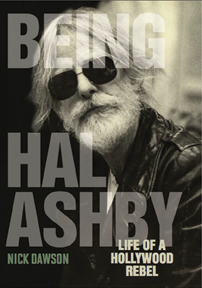(University Press of Kentucky, 456 pages, $37.50)
By Nick Dawson
 Finally a biography of Hal Ashby, who made a series of remarkable movies during the 1970s before falling into disfavor and dying at 59. Ashby is the lost man of the Hollywood Renaissance. His run of hits—Harold and Maude, The Last Detail, Shampoo, Bound for Glory, Coming Home and Being There—was as good as any, yet he is known mainly from Peter Biskind’s Easy Riders, Raging Bulls, which details the familiar and unflattering Ashby legend: beatnik-hippie-pothead, who liked to create chaos on the set. By digging deeply into Ashby’s early life, his family, apprenticeship as one of Hollywood’s most innovative editors, and finally his career as an acclaimed director, Dawson doesn’t so much overturn this perception as grant it greater proportion and clarity. He also disputes rumors about Ashby’s supposed excesses.
Finally a biography of Hal Ashby, who made a series of remarkable movies during the 1970s before falling into disfavor and dying at 59. Ashby is the lost man of the Hollywood Renaissance. His run of hits—Harold and Maude, The Last Detail, Shampoo, Bound for Glory, Coming Home and Being There—was as good as any, yet he is known mainly from Peter Biskind’s Easy Riders, Raging Bulls, which details the familiar and unflattering Ashby legend: beatnik-hippie-pothead, who liked to create chaos on the set. By digging deeply into Ashby’s early life, his family, apprenticeship as one of Hollywood’s most innovative editors, and finally his career as an acclaimed director, Dawson doesn’t so much overturn this perception as grant it greater proportion and clarity. He also disputes rumors about Ashby’s supposed excesses.
Ashby, with a director’s innate focus, characterized his early life thus: “Born in Ogden, Utah. Never a Mormon. Hated school. Mom and dad divorced when I was 5 or 6. Dad killed himself when I was 12.” It should be noted, Ashby was the only member of his family who believed it was a suicide, but as Dawson argues, his lifelong inability to process that trauma lay at the heart of his subsequent anxieties.
Unlike his younger, film school-educated contemporaries, Ashby was a child of the system, working his way up to become editor on a number of Norman Jewison films before stepping behind the camera with The Landlord in 1970. As a director, he favored improvisation and used the script as a mere blueprint, preferring to find a movie’s soul in the editing room. Despite the marvelous results, it was a method that perplexed his financiers, and often, according to Dawson, they were not there to back him up come release day. His creative collaborators, by contrast, recall a freewheeling, approachable, hip father figure, who gently encouraged their best instincts while always integrating the spontaneous and accidental into his work.
Dawson suggests it was the changing tastes in the ’80s and overwork, not cocaine, that ruined Ashby. In the blockbuster era, Ashby failed to find sympathetic backers. Lorimar, for example, took two films away from him in the editing stage (a curious move given that he had won an Oscar for cutting In the Heat of the Night), and reportedly spread rumors of drug abuse and alcoholism, which, based on numerous interviews with friends, Dawson refutes. He concludes that it was more likely Ashby’s driven, workaholic tendencies—twenty-hour days for up to nine months at a time—that did him in. Dawson’s impeccably researched and admirably clear-eyed biography reclaims Ashby from the fog of myth and sets his career in perspective, reminding us again what a loss his death was.
Review written by John Patterson.